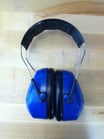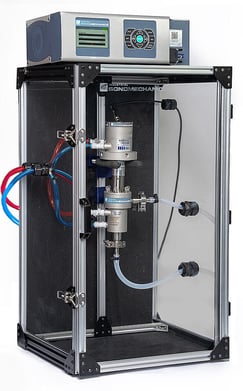 Many of us face the challenge of noisy work environment. In our previous blog post we talked about the noise produced by ultrasonic processors, which, if precautions are not taken, can be loud enough (up to 109 dBA) to cause significant discomfort and even lead to hearing loss. The details can be found at: How Loud is Your Ultrasonic Processor?
Many of us face the challenge of noisy work environment. In our previous blog post we talked about the noise produced by ultrasonic processors, which, if precautions are not taken, can be loud enough (up to 109 dBA) to cause significant discomfort and even lead to hearing loss. The details can be found at: How Loud is Your Ultrasonic Processor?
In most cases, a 20 - 25 dBA reduction in the ultrasonic equipment noise is sufficient for compliance with the U.S. and European occupational noise level regulations for an 8-hour work shift [1]. An additional reduction by approximately 5 - 10 dBA would bring the noise down to a background level for most industrial work environments. An ideal ultrasonic equipment noise reduction method would, therefore, attenuate sound levels by about 30 - 35 dBA across the audible frequency range.
Recommended Noise Reduction Methods
1. Over-the-head Ear Muffs
 The use of over-the-head noise canceling ear muffs is one of the most common methods of reducing unwanted sound. Ear muffs with noise reduction ratings of up to 35 dBA are inexpensive and widely available. Their use, however, may not be convenient at locations shared by many co-workers because it complicates communication and requires everyone in the vicinity of the equipment to wear them.
The use of over-the-head noise canceling ear muffs is one of the most common methods of reducing unwanted sound. Ear muffs with noise reduction ratings of up to 35 dBA are inexpensive and widely available. Their use, however, may not be convenient at locations shared by many co-workers because it complicates communication and requires everyone in the vicinity of the equipment to wear them.
2. Noise Reduction Enclosures
 An alternative solution is to place your ultrasonic processor in a noise reduction enclosure (also known as sound abating enclosure, sonicator enclosure, or sound proof enclosure). When choosing a sound enclosure it is always important to make sure they provide appropriate attenuation values. Most standard ultrasonic sound abating enclosures reduce the noise level by approximately 20 dBA.
An alternative solution is to place your ultrasonic processor in a noise reduction enclosure (also known as sound abating enclosure, sonicator enclosure, or sound proof enclosure). When choosing a sound enclosure it is always important to make sure they provide appropriate attenuation values. Most standard ultrasonic sound abating enclosures reduce the noise level by approximately 20 dBA.
ISM's new noise-reduction enclosure, NRE-30, brings the noise down to a comfortable level that is in compliance with the U.S. and European regulations and allows for a clear 270-degree view of the enclosed equipment. The enclosure is small enough to move around, yet sufficiently large to provide convenient access to the equipment and work product.
Noise Reduction Rating Determination
The experiments discussed below were conducted at Industrial Sonomechanics' product testing facility. The BSP-1200 ultrasonic processor configured in the flow-through mode and operating at the frequency of approximately 20 kHz was tested with and without the corresponding sound reduction enclosure. Noise level data were collected at the distances of two and 15 feet from the processor by using SPLnFFT software, which was shown by the National Institute for Occupational Safety and Health to provide excellent agreement with actual reference values and be reliable for occupational noise exposure assessments [2]. Ultrasonic amplitude settings of 90 and 60 microns were tested using water as the processed medium.
Results and Discussion
The results are presented in the table below:
| Source of Noise | dBA at 2' away | dBA at 15' away |
|---|---|---|
| BSP-1200, 90 microns, without sound enclosure | 106 | 92 |
| BSP-1200, 90 microns, with sound enclosure |
74 | 64 |
| BSP-1200, 60 microns, without sound enclosure |
105 | 88 |
| BSP-1200, 60 microns, with sound enclosure | 73 | 63 |
The data shows that the use of the enclosure reduces the BSP-1200 processor noise to a level well below the maximum allowed by the U.S. and European occupational noise regulations for an 8-hour work shift. Since additional sources of noise may be present, professional assessment should always be performed in each specific work environment to determine what noise reduction is required for compliance with local regulations. As always, we look forward to your comments.
References:
1. How Loud is Too Loud? Bookmark, National Institute of Deafness and Other Communication Disorders, July 2011.
Retrieved from http://www.nidcd.nih.gov/health/hearing/pages/ruler.aspx
2. Kardous, C. A., & Shaw, P. B., Evaluation of smartphone sound measurement applications, The Journal of the Acoustical Society of America, 135(4), EL186-EL192, 2014.
Retrieved from http://scitation.aip.org/content/asa/journal/jasa/135/4/10.1121/1.4865269
.jpg?width=1994&height=332&name=Logo%20Sonomechanics%20White%20No%20Shadow%20R_Final%20(1).jpg)



